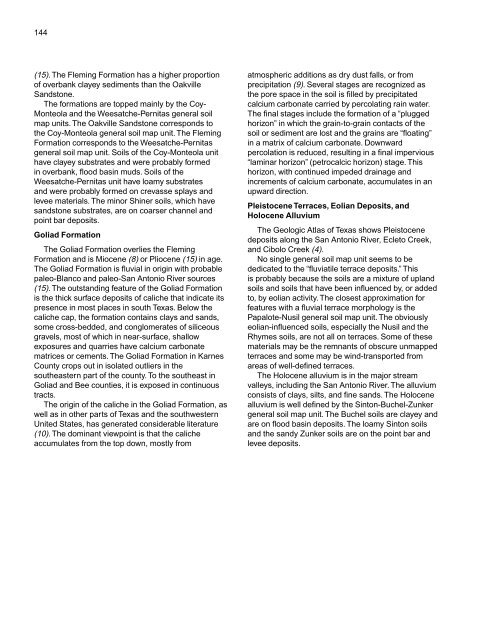Soil Survey of Karnes County, Texas - Soil Data Mart - US ...
Soil Survey of Karnes County, Texas - Soil Data Mart - US ...
Soil Survey of Karnes County, Texas - Soil Data Mart - US ...
Create successful ePaper yourself
Turn your PDF publications into a flip-book with our unique Google optimized e-Paper software.
144<br />
(15). The Fleming Formation has a higher proportion<br />
<strong>of</strong> overbank clayey sediments than the Oakville<br />
Sandstone.<br />
The formations are topped mainly by the Coy-<br />
Monteola and the Weesatche-Pernitas general soil<br />
map units. The Oakville Sandstone corresponds to<br />
the Coy-Monteola general soil map unit. The Fleming<br />
Formation corresponds to the Weesatche-Pernitas<br />
general soil map unit. <strong>Soil</strong>s <strong>of</strong> the Coy-Monteola unit<br />
have clayey substrates and were probably formed<br />
in overbank, flood basin muds. <strong>Soil</strong>s <strong>of</strong> the<br />
Weesatche-Pernitas unit have loamy substrates<br />
and were probably formed on crevasse splays and<br />
levee materials. The minor Shiner soils, which have<br />
sandstone substrates, are on coarser channel and<br />
point bar deposits.<br />
Goliad Formation<br />
The Goliad Formation overlies the Fleming<br />
Formation and is Miocene (8) or Pliocene (15) in age.<br />
The Goliad Formation is fluvial in origin with probable<br />
paleo-Blanco and paleo-San Antonio River sources<br />
(15). The outstanding feature <strong>of</strong> the Goliad Formation<br />
is the thick surface deposits <strong>of</strong> caliche that indicate its<br />
presence in most places in south <strong>Texas</strong>. Below the<br />
caliche cap, the formation contains clays and sands,<br />
some cross-bedded, and conglomerates <strong>of</strong> siliceous<br />
gravels, most <strong>of</strong> which in near-surface, shallow<br />
exposures and quarries have calcium carbonate<br />
matrices or cements. The Goliad Formation in <strong>Karnes</strong><br />
<strong>County</strong> crops out in isolated outliers in the<br />
southeastern part <strong>of</strong> the county. To the southeast in<br />
Goliad and Bee counties, it is exposed in continuous<br />
tracts.<br />
The origin <strong>of</strong> the caliche in the Goliad Formation, as<br />
well as in other parts <strong>of</strong> <strong>Texas</strong> and the southwestern<br />
United States, has generated considerable literature<br />
(10). The dominant viewpoint is that the caliche<br />
accumulates from the top down, mostly from<br />
atmospheric additions as dry dust falls, or from<br />
precipitation (9). Several stages are recognized as<br />
the pore space in the soil is filled by precipitated<br />
calcium carbonate carried by percolating rain water.<br />
The final stages include the formation <strong>of</strong> a “plugged<br />
horizon” in which the grain-to-grain contacts <strong>of</strong> the<br />
soil or sediment are lost and the grains are “floating”<br />
in a matrix <strong>of</strong> calcium carbonate. Downward<br />
percolation is reduced, resulting in a final impervious<br />
“laminar horizon” (petrocalcic horizon) stage. This<br />
horizon, with continued impeded drainage and<br />
increments <strong>of</strong> calcium carbonate, accumulates in an<br />
upward direction.<br />
Pleistocene Terraces, Eolian Deposits, and<br />
Holocene Alluvium<br />
The Geologic Atlas <strong>of</strong> <strong>Texas</strong> shows Pleistocene<br />
deposits along the San Antonio River, Ecleto Creek,<br />
and Cibolo Creek (4).<br />
No single general soil map unit seems to be<br />
dedicated to the “fluviatile terrace deposits.” This<br />
is probably because the soils are a mixture <strong>of</strong> upland<br />
soils and soils that have been influenced by, or added<br />
to, by eolian activity. The closest approximation for<br />
features with a fluvial terrace morphology is the<br />
Papalote-Nusil general soil map unit. The obviously<br />
eolian-influenced soils, especially the Nusil and the<br />
Rhymes soils, are not all on terraces. Some <strong>of</strong> these<br />
materials may be the remnants <strong>of</strong> obscure unmapped<br />
terraces and some may be wind-transported from<br />
areas <strong>of</strong> well-defined terraces.<br />
The Holocene alluvium is in the major stream<br />
valleys, including the San Antonio River. The alluvium<br />
consists <strong>of</strong> clays, silts, and fine sands. The Holocene<br />
alluvium is well defined by the Sinton-Buchel-Zunker<br />
general soil map unit. The Buchel soils are clayey and<br />
are on flood basin deposits. The loamy Sinton soils<br />
and the sandy Zunker soils are on the point bar and<br />
levee deposits.
















